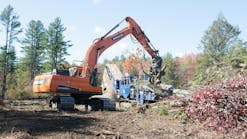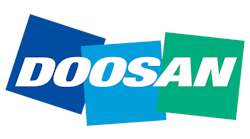The recipe, the ingredients and the tools needed to produce the finish product vary from site to site, taking into account degree of difficulty, locality and soil and rock conditions.
ime factors and a precarious space issue was what Extreme Technologies, Inc. (ETI) of Douglasville, GA, faced with a project at the Georgia Tech campus in Atlanta.
There, a 5,000-square-foot temporary shoring system along two roadways was needed for the installation of foundation walls for a new four-story nanotechnology research facility during the summer of 2006.
The facility was being built at a site that formerly housed a nuclear reactor and research facility, thus prompting the removal of nuclear and radioactive materials and setting the new project three months behind schedule.
Additionally, a variety of utilities inundated the site, including fiber optics and high-pressure steam lines, not to mention water, gas, and phone lines.
“No one knew exactly where they were, so that was a big issue,” notes Randy Greene, operations manager for ETI.
And to make matters even more challenging, the general contractor realized the shoring of the roadside property lines were not in the plans or work scope. Consequently, time was of the essence for the project’s site work.
ETI won the contract to develop a plan for the temporary shoring and help compensate for lost time by completing the installation within 45 calendar days. Schnabel Engineering of Alpharetta, GA, performed the design work.
ETI’s crews employed the use of Geobrugg’s TECCO mesh, having had previous experience with the product on other projects where low headroom was an issue. The high-strength steel wire open mesh is favored by ETI as an economical and effective facing material for anchored slope stabilization system, eliminating drainage needs and facilitating greening.
“This was the only alternative that would really have worked for the issue of time,” says Greene. “Plus, our space was limited.”
TECCO mesh is a diagonal wire mesh made from high-tensile, highly corrosion-resistant wire, the strength of which is akin to wire rope nets. An anchor plate optimizes force transfer from mesh to anchors, allowing the mesh to be pre-tensioned against the slope, restricting deformations in critical surface sections and preventing movement along planes of weakness.
For the Georgia Tech job, ETI excavated 6 feet of material in front of the proposed wall, located just 4 feet from active roadway utilities. Holes were drilled for soil nails at approximately 5-foot centers in a process similar to other slope-face installations. The company used TEI rock drills and a John Deere mini-excavator for the work.
ETI crews rolled out the TECCO mesh, cutting it to the length of the finished wall. After each panel was sized, it was laid on top of a length of black geofabric that was then cut to the same size.
Each mesh/geofabric panel was transported to the top of the proposed wall and then laid side by side with the necessary overlap for stitching together.
After the first two rows of nails were installed, each panel was lowered and installed on the “short” wall section as workers took care to ensure each roll did not become unraveled while retaining the proper two-diamond overlap for correct installation.
As workers excavated more soil and the wall grew in height, more nails were put in and each mesh/geofabric panel was unrolled to cover the new wall length before the spike plates were installed.
This technique was used until the entire wall length was evacuated and secured with the TECCO system. After all of the panels were extended their entire length, compression claws were installed to stitch the mesh into one contiguous panel.
The project was completed within the 45-day deadline and within the budget.
ETI favors the use of TECCO mesh as a replacement for shotcrete because no cure time is needed and, once spike plates are installed, the area can be further excavated.
TECCO mesh has been used in Europe for several years but is just gaining acceptance in North America.
Greene says that’s because getting engineers and others involved in the construction process on board with new products and techniques “sometimes takes a while to catch on.”
But the TECCO mesh, which ETI recently used in another job at a school site, is rapidly gaining acceptance. Greene notes his company gets calls about it on an ongoing basis now.
Chuck Irby, ETI’s president, says using the TECCO mesh on the school site has again demonstrated its usefulness in saving time.
“We don’t have to wait on ready-mix trucks and we don’t have to wait on cure time,” he says. “The very minute we’re done with some nails, we’re lowering the mesh and continuing excavation.”
On a large job site such as the one at Georgia Tech, Irby’s company was able to do its job on one side while excavation was taking place on the other side, he points out.
“It’s constant production every hour; there was no wait time,” he says. “That’s why we use it more than anything, especially when the project’s already behind and they’re waiting on you. We like to save anybody a few days anytime we can.”
About four years ago, the Lincoln Park Zoo in Chicago invested $29 million in the Regenstein Center for African Apes. The 29,000-square-foot facility was constructed to house a number of gorillas and chimpanzees and was designed to allow for fresh air, sunshine, plants, and simulated stands and vines as an environment through which the animals could freely roam.
Construction of the facility included a waterfall and a 500-foot moat that forms a semicircle from one corner of the ape house to another.
A normal 45-degree slope in the area leading down to the moat would not have been possible, as it would have deterred the apes. But a near-90-degree slope would have been a challenge to landscape, and also wipe out the view of the facility.
The moat, sloped to nearly 80 degrees, acts as a 12-foot-deep by 20-foot-wide barrier between the outside activity area and a raised concrete wall and railing, protecting zoo patrons and allowing for maximum visibility while promoting the natural setting.
In constructing the project, one challenge was the creation of the natural vegetation along the slope due to the pitch and the Lake Michigan-type sandy soil at the facility site.
The Thomas Madden Co. of Carol Stream, IL, worked on the slope project in conjunction with Contech Construction Products on an approach that would be technologically feasible while retaining aesthetics.
Jerry Heniff, project engineer, chose Tensar Geogrids to hold the slope and allow for landscaping.
“The slope had to be close to vertical, but the zoo owners didn’t want a concrete-type surface; they wanted a surface they’d be able to landscape to make it look more natural,” he says. “The slope had to separate the animals from the public. There were certain regulations about the depth of the moat.”
Tensar Biaxial (BX) and Uniaxial (UX) geogrids are made of continuous sheets of polypropylene and high-density polyethelene. They accommodate heavy construction on sites with weak soil, thereby minimizing or eliminating soil stabilization or other foundation work in such applications as retaining walls, slopes, streets, and parking lots.
The product works by internally reinforcing all types of soils and construction material, creating a stiffened, reinforced prism to create critical engineered structures.
“This was the only product proposed that would allow us to put plantings on the soil,” says Heniff. “There were other options, but nothing allowed the degree of slope and the flexibility for the plantings.”
After rough grading at the zoo site, crews worked the area by hand, compacting 12 inches of sandy soil along the slope in 20- by 50-foot sections. Tensar Uniaxial structural geogrid was laid in for primary reinforcement, followed by Tensar Biaxial geogrid for secondary reinforcement in alternating 18-inch layers.
It was topped with about 2,000 cubic yards of backfill material compacted to a depth of 12 inches, allowing landscapers to complete the project with hundreds of plants and grasses along the surface and edges. The geogrid allowed for vegetation between the water and simulated jungle.
One of the several challenges was a tight time schedule.
“There was a date when everything to be completed for an opening ceremony,” says Heniff. “The Tensar work had to be done in a short period of time.”
Another challenge was getting the backfill materials, says Heniff.
“While other materials would have been more desirable, we were required by the owners to use as much of the existing materials onsite as much as we could,” he says.
Because the project was located close to Lake Michigan, the onsite materials were sandy.
“That doesn’t work too well when you’ve got an open mesh product you’re using to hold that backfill in position,” Heniff points out. “It tends to squeeze out the end of each layer.
“We brought the sand backfill up towards the face of the slope and stopped a foot or two before the end, and then we used topsoil and filled it in and wrapped the fabric back and started the next layer with the sand backfill and topsoil again.”
The Thomas Madden Co. had not done too many projects similar to this one with an 80-degree slope, says Heniff.
“That was the part of the engineering of the Tensar materials,” he says. “Generally, when we do excavating work, we have to make the slopes 1:1, which would be like a 50% slope. But the way the Tensar is designed allowed us to reach the 80%.
There were some people in the general contractors’ office and the zoo office who were a little skeptical about building a slope so steep, but the Tensar product worked well.”
Heniff saw the project a year after construction. “It looked like a wall of vegetation,” he notes.
Roadside failures are always a call for slope stabilization in order to ensure future safety.
Glade Creek Road is an access road to camp areas within the New River Gorge National Park area in West Virginia. There had been roadway failures in seven locations along the road. Orders Construction in St. Albans, WV, was called in to do a slope-stabilization project along the road on behalf of the Federal Highway Administration to create a safer roadway.
The project was initiated during the spring of 2007 and was continuing during spring 2008.
As is the case for many companies doing slope-stabilization work under such circumstances, access was the biggest challenge, engineer Jared Clonch points out.
“There was one way in and one way out, so we just worked it from one end to the other,” he says.
Some 20,000 yards of material were excavated and Orders Construction put back about 23,000 yards of granular fill behind the walls, included drainage work, pipes, and inlets.
While Orders Construction considered other options, products from Maccaferri Gabions were chosen for the economy of price, Clonch says.
In executing the job, Orders Construction crews created a welded “L” panel wall system with Maccaferri’s MacGrid WG-04 and WG-09 and MacMat N10, as well as MacTex MX-245 and MX-340, which are geotextiles.
MacGrid WG series of woven geogrids are used primarily in mechanically stabilized earth and reinforced soil slope structures of any height and for stabilizing and reinforcing subgrades.
The geogrids consist of a polyester core encased in PVC sheathing, allowing the use of a variety of backfill, from large granular fill to more cohesive materials. Uses of MacGrid reinforced soil slopes focus on vegetation; thus, a wedge of topsoil is placed behind the reinforced slope face. Additionally, a biodegradable blanket is installed to prevent the topsoil and fill from spilling through the grid’s apertures and also accelerating slope vegetation.
The MacMat product is a turf-reinforced mat used as a permanent erosion control blanket consisting of ultra violet-stabilized, nondegradable synthetic fibers, providing protection on upland slopes, stream banks, wetland boundaries, and shorelines.
MacMat is a roll erosion-control product made of a three-dimensional geomat consisting of entangled polypropylene monofilaments heat-bonded at the contact points for a dimensionally stable matrix for soil erosion protection. In some cases, it’s used in conjunction with double-twist wire-mesh reinforcement for long-term root reinforcement, erosion control, and revegetation.
MacTex is a high-strength woven geotextile made from polyester fiber and widely used in construction as a separation and reinforcing layer. The product, made from woven polyester, is resistant to ultraviolet degradation and chemical environments normally found in soils.
MacTex can be used as a base reinforcement of embankments over soft foundations, reducing embankment differential settlement and over voids in areas prone to subsidence due to washout or mine workings.
Among the equipment used at the job site were Komatsu PC300 and 200 excavators, a Komatsu PC78 mini-excavator to dress the slopes and do headwall excavation below the walls, and an integrated tool carrier with a swivel bucket from Komatsu, as well as bulldozers, graders, and rollers.
Meeting a construction site’s tight time frames is a priority when Key West Retaining Systems in Wilsonville, OR, does its job. Consequently, the company has used more than one million square feet of Lock+Load Retaining Wall System’s products in its projects, says Tim Mann, sales manager and head of the estimating and building department.
The Lock+Load Retaining Wall System’s modular design combines two high-strength, lightweight, fiber-reinforced concrete components into a single, rigid, cantilevered unit, which is used to build short walls or used in conjunction with soil reinforcement for tall retaining structures.
The design allows for guardrails, barriers, or fences to be positioned directly behind the wall face to maximize usable space. Each module-also called a stone-can serve as an independent stability structure to address differential settlement problems.
One of Key West’s many slope-stabilization projects took place recently in Lincoln City, OR, at a multifamily residential construction site where the company has installed walls up to 20 feet and beyond to shore up the area for the buildings and parking lot.
One of the biggest challenges was access, as well as weather, points out Mann. If either one of the two presents a hindrance, it holds up the process.
The ultimate goal in this project was to shore up the hillside so the construction crew could build in a timely fashion, Mann comments.
“They”˜re in a time crunch, so they need something that can go in quick and get done,” he says. “As far as modular systems, Lock+Load is a system that is really quick to put in.”
Key West Retaining Systems planned to install 20,000 square feet of Lock+Load material. Job-site equipment included track hoes, skid-steers, compaction equipment, rollers, and bulldozers.
While poured-in-place concrete was one option, Mann notes, it was rejected as being too costly and not as efficient.
“That can’t compete with the Lock+Load system, where you can get tight compaction right to the back of the unit itself,” says Mann. “With modular block, you can’t do that because it simply won’t hold up. Our unit is nonstacking, therefore, it sits on the backfill, rather than the unit itself, so each unit is independent of one another.”
At Searle Brothers Construction in Rock Springs, WY, the Edge Material Unroller from CE Attachments in Cedarburg, WI, is used for the company’s slope stabilization jobs.
Although most of the work Searle Brothers does is in the low country where there is not a lot of erosion, when erosion control is needed, the company uses a mesh fabric-type of erosion control.
The fabric often is used in conjunction with different-sized rocks in projects where the company is trying to stop water from creating erosion.
In a recent project, Searle Brothers teamed up the Edge Material Unroller and a Bobcat T-300 to lay fabric down within a 2:1 slope inside of a tailings dam for erosion control for General Chemical Industrial Product’s soda ash plant in Green River, WY.
“We were putting the material down, and they would dump their tailings down the side of the pond,” says Raymond Searle, the company’s president. “The goal was not to erode the banks as the tailings were coming out of the pipes.”
Searle says before his company used the Edge Material Unroller with the Bobcat T-300, “we used to have a trailer we sat on top and we used to run back and forth, up and down the hill. With this, we can run the Bobcat right down to the bottom, cut it off, turn it around, run right back up.”
Searle says the combination of the two cuts work down by 50%.
“Typically, a job would have about six to eight men; you’d been wearing them out,” he says.
Additionally, it cut down on the amount of energy exerted by workers moving up and down hills, he says, adding that the setup ultimately saves on labor, time and money.
The Bobcat T-300 is the only machine Searle has found can handle the slopes, as it provides better traction.
“It’s got a hookup to the hydraulics and a long pole. We had to modify it a little bit because the rolls we were putting on there were too heavy for the pole. The rolls we were laying out probably weighed 500 to 600 pounds, so we had to beef up the pole a little bit,” he says.
“We just run the pole through the roll of fabric and tie off the ends so it wouldn’t roll off and then that attachment moves left or right of the Bobcat according to whichever way you are going. You unroll it a little bit and set something on it or have people stand on it and you take off. It unrolls itself.”
Searle also uses Edge’s grabbing tools, used to pick up and place rocks in landscaping, to remove invasive plants and trees (including roots), and to remove fence posts, stumps, and debris.
“Those sure were handy,” he says. “I used them on a clearing job in Utah, and they were phenomenal. We’ve used them on a couple of jobs for moving concrete. They are worth their weight in gold.”



